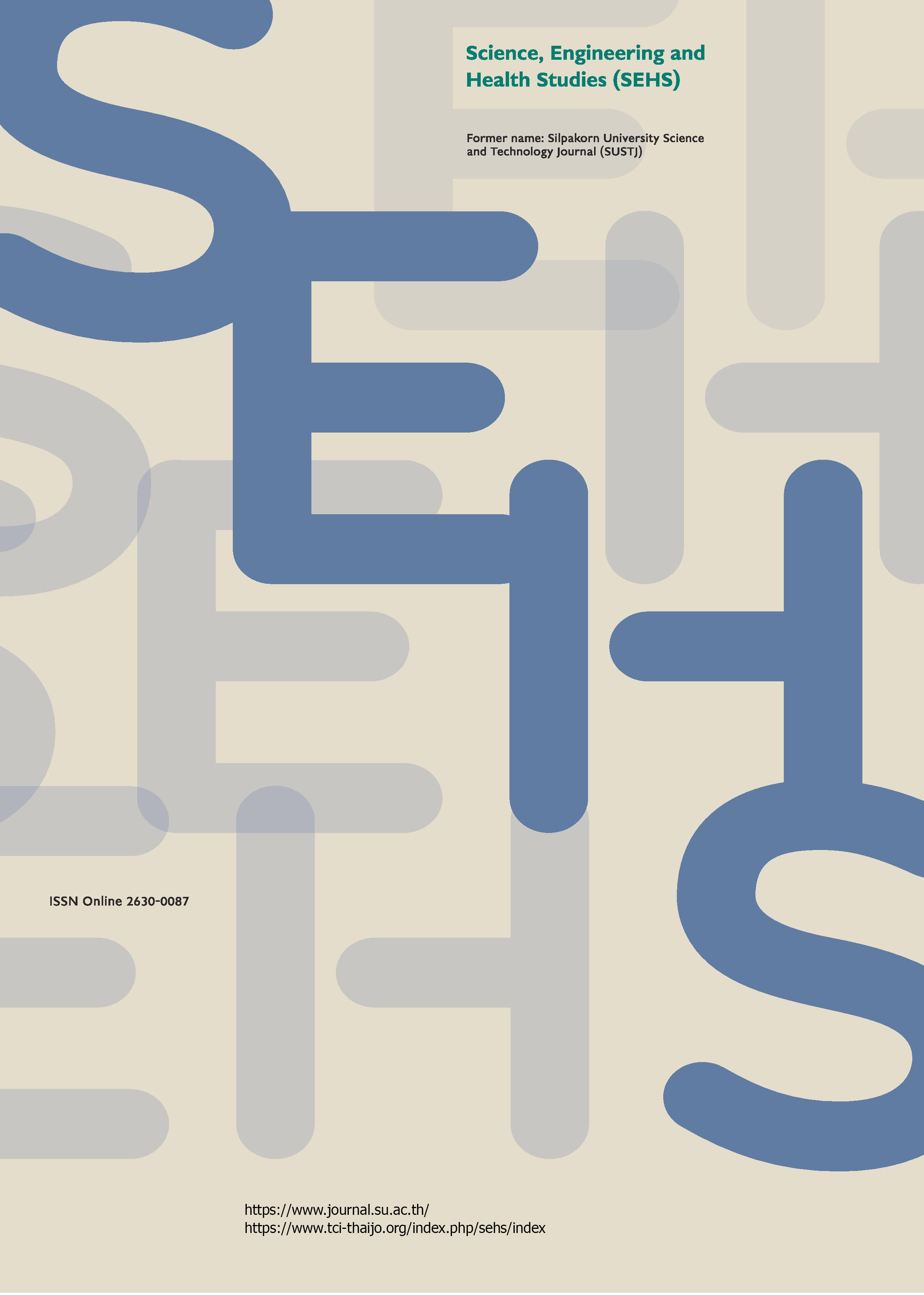Distribution of precipitable water over Thailand using MTSAT-1R satellite data
Main Article Content
Abstract
In this study, we investigated the long-term spatial distribution of atmospheric precipitable water vapor (PWV) in Thailand using a statistical model that relates the satellite-derived brightness temperature to the PWV. In the validation process, we used an independent dataset obtained from PWV measurements at four stations, for which the mean of the PWV is 4.42±1.06 cm and that of the model is 4.42±0.89 cm. This result indicates that the model performs well. After validation, the model was used to calculate PWV based on satellite data for the whole country at a spatial resolution of 4 km 4 km and the results of which are presented as monthly and yearly PWV maps. The monthly PWV maps reveal that the PWV values are relatively high throughout the country during the wet season (May-October) and low in the dry season (November-April). The yearly PWV map indicates that the PWV varies with latitude, with low values in the north that gradually increase to high values in the south.
Downloads
Article Details
References
Akatsuka, S., Oyoshi, K., and Takeuchi, W. (2010). Mapping of precipitable water using MTSAT data. In Proceedings of 31st Asian Conference on Remote Sensing (ACRS), pp. 1584-1589. Hanoi, Vietnam.
Basha, S. G. (2013). Studies on Vertical Distribution of Atmospheric Water Vapor: Atmospheric Water Vapor, Germany: Lambert Academic Publishing, pp. 1-39.
Charoenphon, C., and Satirapod, C. (2020). Improving the accuracy of real-time precipitable water vapour using country-wide meteorological model with precise point positioning in Thailand. Journal of Spatial Science, 2020, 1-17.
Cuomo, V., Tramutoli, V., Pergola, N., Pietrapertosa, C., and Romano, F. (1997). In place merging of satellite based atmospheric water vapour measurements. International Journal of Remote Sensing, 18(17), 3649-3668.
Exell, R. H. B. (1978). The water content and turbidity of the atmosphere in Thailand. Solar Energy, 20(5), 429-430.
Gurbuz, G., and Gin, S. (2017). Long-time variations of precipitable water vapour estimated from GPS, MODIS and radiosonde observations in Turkey. International Journal of Climatology, 37(15), 5170-5180.
Hakuba, M. Z., Folini, D., Sanchez-Lorenzo, A., and Wild, M. (2013). Spatial representativeness of ground-based solar radiation measurements. Journal of Geophysical Research: Atmosphere, 118(15), 8585-8597.
Halthore, R. N., Eck, T. F., Holben, B. N., and Markham, B. L. (1997). Sun photometric measurements of atmospheric water vapor column abundance in the 940-nm band. Journal of Geophysical Research: Atmospheres, 102(D4), 4343-4352.
Hay, J. E. (1971). Precipitable water over Canada: II Distribution. Atmosphere, 9(4), 101-111.
Iqbal, M. (1983). An Introduction to Solar Radiation. New York: Academic Press, pp. 128-133.
Janjai, S., Masiri, I., Pattarapanitchai, S., and Laksanaboonsong, J. (2011). An improved model for the estimation of solar radiation from satellite data for Thailand. Journal of the Institute of Engineering, 8(3), 130-139.
Janjai, S., Nimnuan, P., Nunez, M., Buntoung, S., and Cao, J. (2015). An assessment of three satellite-based precipitation data sets as applied to the Thailand region. Physical Geography, 36(4), 282-304.
Kämpfer, N. (2013). Introduction. In Monitoring Atmospheric Water Vapour (Kämpfer N., eds.). pp. 1-7. New York: Springer.
Larsen, N. F., and Stamnes, K. (2005). Use of shadows to retrieve water vapor in hazy atmospheres. Applied Optics, 44(32), 6986-6994.
Lee, K. M., and Park, J. H. (2007). Retrieval of total precipitable water from the split-window technique in the East Asian region. In Proceedings of the EUMETSAT Meteorological Satellite Conference, pp. 1-8. Amsterdam, Netherlands.
Liu, H., Li, H., Tang, S., Duan, M., Zhang, S., Deng, X., and Hu, J. (2020). A physical algorithm for precipitable water vapour retrieval over land using passing microwave observations. International Journal of Remote Sensing, 41(16), 6288-6306.
Masiri, I., Nunez, M., and Weller, E. (2008). A 10-year climatology of solar radiation for the Great Barrier Reef: implications for recent mass coral bleaching events. International Journal of Remote Sensing, 29(15), 4443-4462.
Nunez, M. (1993). The development of a satellite-based insolation model for the tropical western Pacific Ocean. International Journal of Climatology, 13(6), 607-627.
Phokate, S., and Atyotha, V. (2018). Determination of the amount of water vapor in the troposphere over Thailand using surface data. Kasem Bundit Engineering Journal, 8, 364-372.
Prabhakara, C., Chang, H. D., and Chang, A. T. (1982). Remote sensing of precipitable water over the oceans from Nimbus 7 microwave measurements. Journal of Applied Meteorology and Climatology, 21(1), 59-68.
Reitan, C. H. (1960). Distribution of precipitable water vapor over the Continental United States. Bulletin of the American Meteorological Society, 41(2), 79-87.
Takeuchi, W., Nemoto, T., Kaneko, T., and Yasuoka, Y. (2010). Development of MTSAT data processing, distribution and visualization system on WWW. Asian Journal of Geoinformatics, 10(3), 29-33.
Taylor, F. W. (2005). Elementary Climate Physics. Oxford: Oxford University Press, pp. 104-118.
Wang, P. K. (2013). Physics and Dynamics of Clouds and Precipitation. Cambridge: Cambridge University Press, pp. 1-26.
Wolberg, J. (2006). Data Analysis Using the Method of Least Squares: Extracting the Most Information from Experiments. Berlin: Springer, pp. 31-71.
Wong, M. S., Jin, X., Liu, Z., Nichol, J. E., Ye, S., Jiang, P., and Chan, P.W. (2015). Geostationary satellite observation of precipitable water vapor using an empirical orthogonal function (EOF) based reconstruction technique over eastern China. Remote Sensing, 7(5), 5879-5900.


